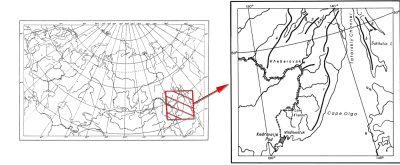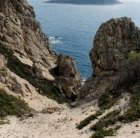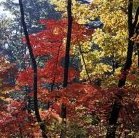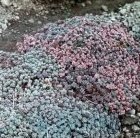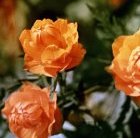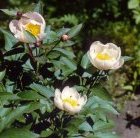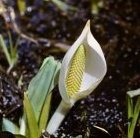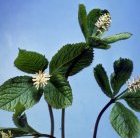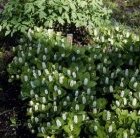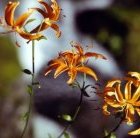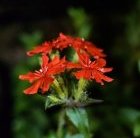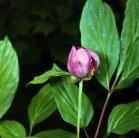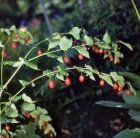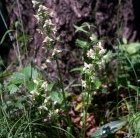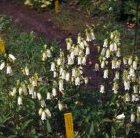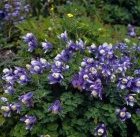 |
QUICK SEARCH
MO PROJECTS:
Africa
Asia/Pacific
Mesoamerica
North America
South America
General Taxonomy
Photo Essays
Training in Latin
America
MO RESEARCH:
Wm. L. Brown Center
Bryology
GIS
Graduate Studies
Research Experiences
for Undergraduates
Imaging Lab
Library
MBG Press
Publications
Climate Change
Catalog Fossil Plants
MO DATABASES:
W³MOST
Image Index
Rare Books
Angiosperm
Phylogeny
Res Botanica
All Databases
INFORMATION:
What's New?
People at MO
Visitor's Guide
Herbarium
Jobs & Fellowships
Symposium
Research Links
Site Map
Search
ORNAMENTAL PLANTS IN THEIR NATURAL HABITATSThe Far East Russia
The Russian Far East extends over 3.500,000 square kilometers (1.350,000 sq miles), stretching between East Siberia and the Pacific Ocean. Cape Dezhneva, discovered in 1648 by the Cossak Dezhnev, is the easternmost point in Asia, situated at longitude 169°39' W. The Russian Far East includes the Primorskiy and Khabarovskiy Territories or "kray" in Russian, the Amur and Magadan Regions, the Kamchatka Peninsula and the Sakhalin, Kommandorskye and Kuril Islands (Kuril’skye Ostrova). The Arctic Ocean forms its northern boundary and the Bering Sea, the Sea of Okhotsk and the Sea of Japan lie at its eastern shores. The southern boundary of the Russian Far East runs along state frontiers with China and Korea. This region is of great interest for botanists, geologists, and even volcanologists, about 100 volcanoes occur on Kamchatka and 20 of them remain active. The southern part of the Far East is the richest one, and therefore, of the most interest to botanists. This area belongs to two floristic regions: 1) the Manchurian and Sakhalin-Hokkaido Provinces of the Eastern Asiatic Region; and 2) the Transbaykalian Province of the Circumboreal Region (Takhtajan, 1986). This encompasses the southern part of Siberia,
The vegetation cover of the Russian Far East is diverse. The luxuriant woody flora predominates in the Primorskiy Kray and the Amur River region, southern Sakhalin and the southern Kuril Islands and consists almost entirely of deciduous forests. This is a basic feature distinguishing this provincial vegetation from that of adjacent regions in Siberia. Prairie-steppes and meadow-steppes are common on the Prekhankaiskaya and the Zeya-Bureyskaya plains. The Manchurian province is characterized by high endemism, including Microbiota (M. decussata), the only endemic coniferous genus within the flora of the FSU. The Sakhalino-Hokkaido province has a considerable number of narrowly endemic species. Among four Far Eastern generic endemic the most interesting is Miyakia (Ranunculaceae) that occurs only in East Sakhalin Range. The total number of ornamental species cannot be accurately determined, because no such an analysis has been done. However, regional studies of individual areas give us a fairly adequate picture of its introduction possibilities. Thus, from the southern Far East more than 150 species of ornamental perennial plants were offered . 250 species taken from Sakhalin and the southern Kuril Islands were tested in different botanical gardens. The rich herbaceous cover of the Far Eastern broad-leaved forests can be a source for not less than 125 species. These potentially new horticultural herbs can be grown in temperate zones. Taxonomic studies of the flora of the region show that the buttercup family, Ranunculaceae, is one of the richest in ornamental species, including the genera Aconitum, Adonis, Aquilegia, Cimicifuga, Delphinium, Pulsatilla and Trollius. Less numerous but well represented are the daisy family with the genera Artemisia, Aster and Heteropappus, the bellflower family including Adenophora, Campanula, Codonopsis and Platycodon, the lily family (s.lat.) with Fritillaria, Lilium, as well as the saxifrage family including Astilbe, Bergenia and Saxifraga. Several genera in the Far East have numerous ornamental representatives. The genus Viola (violet or pansy) has ca. 40 species and Aconitum (monkshood) ca. 30 species. Classical horticultural genera such as Rhododendron, Lilium, Iris, Primula, Geranium, Corydalis and Pulsatilla contain about 10 species each. The Far East also includes some native taxa that gave rise to large horticultural complexes. Among them are Callistephus chinensis, the ancestor of the cultivars of the annual China aster, and Paeonia lactiflora that served as the initial germplasm for the almost entire multiplicity of paeony cultivars. Both species came into the garden worldwide from China. Numerous interesting plants grow in the vicinity of Vladivostok and in the surrounding areas. Botanical excursions can be made around the locales of the Okeanskaya station and the Bay of Tikhaya, Kiparisovo (Nadezdinskiy district), Anisimovka (Shkotovskiy district), Dalnegorsk as well as Popov and Reinike islands. Each of these has diverse plant communities, but by far the most fascinating place is the "Kedrovaja Pad" reserve. The "Kedrovaja Pad" reserve was founded in 1916 and is one of the oldest in the country. The reserve is situated in the Primorskiy Region on the west shore of the Amur Bay. The reserve covers 1,800 hectares (ca. 4,400 acres) across the foothills of the Chorny Mountains. The Sukhorechenskiy and Gakkelevskiy ranges that cross the reserve have an average of 300-400 m (1,000-1,300 ft), and the highest peak, Uglovaya, is 700 m (2,300 ft). All the northern slopes are gentle, whereas the southern slopes are steep and rocky. The climate of this region differs very much from that of the other Far East regions, for it is under the influence of tropical cyclones, which is especially important during the growing season. A visit to the Kedrovaja Pad reserve provides a wonderful opportunity to get to know a unique type of forest, peculiar in its richness. The unusual appearance of these forests results from the striking abundance of epiphytes, vines and woody lianas that wind around tree trunks to lengths of 20 m (65 ft) or more. The impression is that of a tropical rain forest, but here the main tree species are Manchurian fir Abies holophylla, Mongolian oak Quercus mongolica, Manchurian ash Fraxinus mandshurica and poplar Populus maximowiczii. Some trees, for example an elm, Ulmus japonica, are as tall as 30 m (100 ft) or more. The understory consists of many woody and herbaceous species among them a number from the ginseng family Araliaceae: Aralia continentalis, A. cordata, A. elata, Eleutherococcus senticocus, E. sessiliflorus, Kalopanax septemlobus, Oplopanax elatus as well as inestimable ginseng Panax ginseng. All of these are valuable medicinal plants. Nowhere else in the FSU can botanists find as many invaluble members of the Araliaceae as in the Far East. The Amur cork tree, Phellodendron amurense (Rutaceae), is also characteristic of the Far East. It occurs in clearings and valleys and one can recognize the tree immediately by its wonderful delicate foliage, which becomes bright yellow in the autumn. A birch, Betula schmidtii, which is known as iron birch in Russian because of the metallic violet tint of its dark grey bark, grows in the mountain hills. In some places, the Japanese yew, Taxus cuspidata, catches the eye. This plant occurs in many areas in the Sikhote-Alin and the Japanese Sea islands having various life-forms. It can be a tall tree, a shrub with many trunks, or a dwarf shrub with prostrate branches up to 4 m (13 ft) long. Along the sea shore, a visitor may meet Alnus japonica, which is closely related to the seaside alder, Alnus maritima, of North America. Botanists have found many such pairs of closely related species, one occuring in America the other in the Far East. The umbrella leaf Diphylleia (Berberidaceae) is a good example. The genus has only three species with one, D. cymosa, occuring in northeastern (Appalachia) North America; the other two in the Far East. D. grayi occurs on Sakhalin, in Japan, and in mainland China, D. sinensis occurs in Japan. Other common genera have Asian-American disjunctions e.g., the skunk cabbage genus Lysichiton is represented by the white skunk L. camtschatcense on Kamchatka, Sakhalin, the Kuril
The Kedrovaja Pad reserve is interesting to visit in any season. Herbaceous plants flowering from early spring till late autumn provide a magnificent display. Adonis amurense is one of the earliest plants to bloom, and its bright yellow flowers can be seen among patches of snow. At the same time or just a little later, the white-blue flowers of the liverleaf, Hepatica asiatica, and a violet, Viola rossii, begin to appear. These plant come into flower before their leaves develop. This peculiarity is shared by Hylomecon vernalis of the poppy family.
In many places in the Kedrovaja Pad reserve one can see the familiar Jack-in-the-pulpit, Arisaema amurense, which has an erect green spathe with purple margins and purple or violet stripes inside. Rhododendron shrubs make a colourful display on rocky hillsides. Two species growing in the reserve are deciduous plants on which the flowers appear before the foliage: Rhododendron mucronulatum ranges to 3 m (10 ft) tall with large (5-6 cm/2-2.4" diam.) purple-pink flowers; R. schlippenbachii reaches 2 m (6.5 ft) height and has light pink flowers (7-8 cm/2.8-3.2" diam.) crowded at the tips of branches. This latter species is rare in the reserve, yet is very common in Khasanskiy Region. It is a very attractive species, and is probably the undisputed gem of the genus in the Far East. Members of the lily family make a magnificent display during early and mid summer. In clearings and meadows, a profusion of lilies can be seen: Lilium buschianum, L. cernuum, L. distichum, L. pensylvanicum and L. pseudotigrinum. All are attractive with large and splendid flowers of different shapes and hues, and are of outstanding beauty and very desirable for the garden. The local daylily, Hemerocallis middendorffii, is practically unknown in cultivation outside Russia. Its bright orange-yellow flowers are in compact clusters at the tops of stems, and each inflorescence has four or more flowers up to 10 cm (4") long. This daylily species deserves special attention because of its potential value for hybridization. Fritillaria ussuriensis may not be as attractive as the above-mentioned species. However, it is an elegant plant with purplish brown flowers in campanulate shapes topping stems as tall as 60 cm (2 ft) and leaves with delicate tendril-like tips. One of the most valuable plants in the reserve is Paeonia lactiflora. This particular species is ancestral to many of the cultivars we have today. These paeonies grow most frequently in clearings and other sunny habitats. When in bloom they produce large white or pink flowers, numerous even in the wild. Coming into flower simultaneously with the paeonies are representatives of the bellflower family. Campanula punctata, with its white, tubular-bell-shaped flowers, appears first of all, on river shallows and
Those travelling southward to the Chinese border should know that they will arrive, not only at an administrative border, but at natural border as well. A trip from the reserve to the south allows one to observe certain plant species for which these regions form the northern extent of their distribution areas. Here grows the woody liana Boston ivy, Parthenocissus tricuspidata, especially abundant on Falshiviy Island and on the cliffs on the cape of Golubiniy Utes. Its main distribution area is Japan, Korea and China. Along the Japanese sea shore another woody vine climbs vigorously on rocky places, the Kudru vine, Pueraria lobata of the pea family. Its climbing stems to 6 m/19 ft long bear trifoliolate leaves, and large, fragrant, violet-purple flowers borne in long axillary racemes. Aristolochia manshuriensis is closely related to A. durior, the Dutchman's pipe, which is also a liana with rounded heart-shaped leaves up to 30 cm (1 ft) long, and stems up to 15 m (50 ft) tall. All three aforementioned lianas are very attractive. Botanists and plantsmen are very impressed when they see the aquatic plants Brasenia schreberi, Euryale ferox and Nelumbo komarovii. They are relatively rare in the Far East today and are considered to be vanishing species. All three belong to tropical families, the Cabombaceae, the Nymphaeaceae and the Nelumbonaceae respectively. To the north of Vladivostok on the Sikhote-Alin foothills, one can see coniferous broad-leaved forests, shrub thickets and mountain tundra. There are some ornamentally interesting taxa here including shrubs and perennials. Among the shrubs are two rhododendrons. Rhododendron aureum is an evergreen shrub to 0.3-1 m (1-3 ft) tall, with clusters of 3 to 5 yellow flowers, closely related to R caucasicum, which has white flowers. The other species is R. redowskianum, a remarkably tiny, deciduous
Of special interest are the tall plant communities that include herbaceous plants up to 4 m (13 ft) tall, often with arresting bold foliage. This vegetation type can be seen in the Far East in the southeastern regions of the Kamchatka Peninsula, on southern and central Sakhalin (up to 52° N), on the Kuril Islands (up to 46° N) and on the continent near the Tatarskiy Channel. The number of species is not very large, but often includes Aconogonon weyrichii [=Polygonum weyrichii], Angelica sachalinensis and A. ursina, Cacalia robusta [=Parasenecio], Petasites amplus and P. tatewakianus as well as Reynoutria sachalinensis [=Polygonum sachalinensis]. Most of these species have very large leaves. Accordingly, leaves of Petasites amplus and P. tatewakianus may reach 1.5 m (ca. 5 ft) across and look like large umbrellas. Also in this plant community are found Aconitum fischeri, Anthriscus sylvestris, Cirsium kamtschaticum, Filipendula camtschatica, Heracleum lanatum, Senecio cannabifolius and Urtica platyphylla. These plants grow astonishingly fast in the spring, gaining up to 10-15 cm (4-6") in height a day with Filipendula camtschatica. All these species can be used to form a wild garden or as it is sometimes called, "herbaceous jungle". It is noteworthy that these species are not as tall in other parts of their distribution ranges. The forests of the Far East possess a wealth of botanical material. There are about 90 ornamentally useful species in the forests on Sakhalin and the Kuril Islands. The early spring flora is especially abundant in these forest formations. In damp and swampy places Lysichiton camtschatense and Symplocarpus renifolius flower before leafing.
Magnolia hypoleuca is the only Magnolia native to the FSU, and it also grows in south Kunashir, producing lovely, fragrant flowers. The shrub Hydrangea paniculata and the liana H. petiolaris
Although meadows do not occupy wide areas in the Far East, they include more than 60 species of ornamental plants. The list includes the orchids Amitostigma kinoshitae, Cypripedium guttatum, C. macranthon and Dactylorhiza aristata as well as Adenophora species,
The lengthy and deeply indented coastline of the Far East provides large areas of exposed gravel slopes and ridges that support a number of ornamental plants. The most widespread species on the rock exposures of Sakhalin and the Kuril Islands are Aquilegia flabellata, Dianthus superbus, Draba borealis and Saxifraga sachalinensis. The rare plants include Orostachys furusei [=O. aggregata], a plant with numerous flower stems, Rhodiola integrifolia, with dark red flowers and speedwell Veronica grandiflora, a tiny plant but with flowers 1.5-2 cm (0.6-0.8") in diam. Bergenia pacifica, Chrysanthemum zawadskii [=Dendranthema zawadskii], Orostachys malacophylla, Rhododendron schlippenbachii, R. sichotense, Scutellaria baicalensis and Sedum kamtschaticum are among the rock plants of the continental Far East. There are about 50 species of ornamental plants that grow in the rocky habitats of the islands, of which 20 occur on the continent. Among the endemic taxa, the most peculiar is Miyakea integrifolia, a generic endemic of Sakhalin. Although most Russian botanists treat Miyakea as a distinct genus, others include it in Pulsatilla, pasque-flower, because of the similarity of their flowers. The differences are that the monotypic Miyakea has simple, ovate to oblong, glossy leaves with recurved margins, whereas all Pulsatilla species have deeply lobed leaves. Two miniature, mat-forming bellflowers, Campanula chamissonis and Campanula lasiocarpa, may be encountered on the dry stony upland slopes of the Kuril Islands. The ornamental Dicentra peregrina, a spectacular perennial with grey leaves and pink flowers and Pennellianthus frutescens [=Penstemon frutescens] both have close relatives in North America. Saxifraga merckii, with white flowers, grows in stony habitats and may well be used in the rock garden. Primula cuneifolia, a tiny primrose with umbrella-like inflorescences, grows in damp meadows. |
|||||||||||||||||
| ORNAMENTAL PLANTS FROM RUSSIA |
© 1995-2025 Missouri Botanical Garden, All Rights Reserved
4344 Shaw Blvd.
St. Louis, MO 63110
(314) 577-5100
Technical Support
